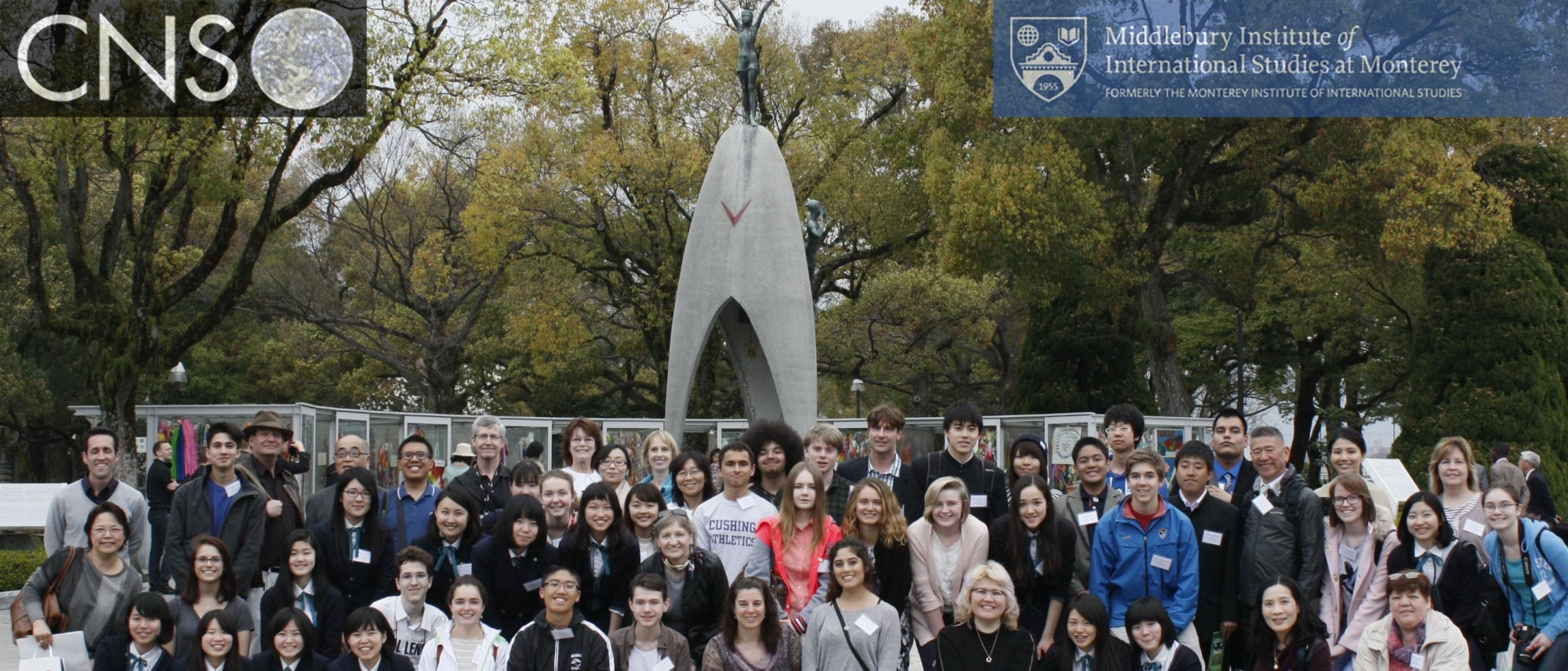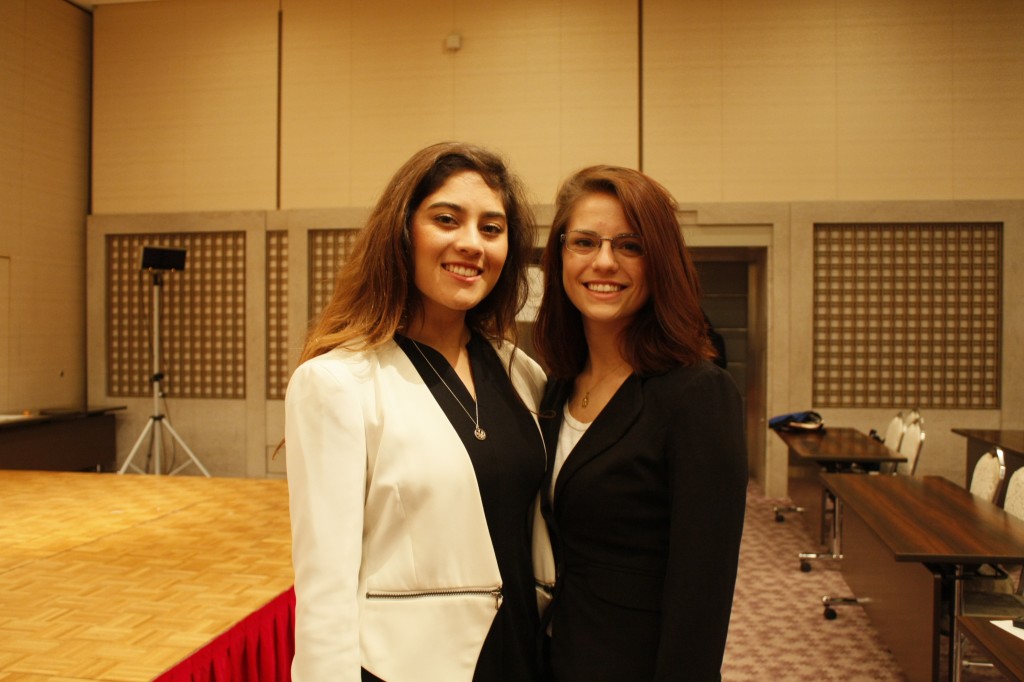Galina Salnikova and Nelli Porseva, a student and teacher at Gymnasium 164 in Zelenogorsk, Russia were featured in their local TV news! (Available only in Russian)

Galina Salnikova and Nelli Porseva, a student and teacher at Gymnasium 164 in Zelenogorsk, Russia were featured in their local TV news! (Available only in Russian)

Shaden Beltran (left) and Laura Colosky (right) at the 2015 CIF
Shaden Beltran was a student at the Santa Catalina School who attended the 2015 Spring CIF Conference, held in Hiroshima, Japan to commemorate the seventieth anniversary of the bombings in Hiroshima and Nagasaki. During the span of four months, Shaden and her partner, Laura, worked on two mini projects in order to prepare for their final deliverable.
The topic of their final project was nuclear disarmament through a humanitarian approach. Although different groups suggested different methods on how to achieve the goal nuclear disarmament, all of the students at the conference were aware of the dangers nuclear weapons pose.
Only, Shaden was not one hundred percent convinced that nuclear weapons actually threaten today’s society. She lacked sympathy towards the hibakusha (survivors of the a-bomb attacks) and their deceased loved ones. In fact, when she arrived in Hiroshima, she was quick to notice that the buildings were tall and that there was a large portion of vegetation. The people were extremely nice and always greeted her with big smiles. Their lifestyle and the physical appearance of the city made it even more difficult to understand the true dangers of nuclear weapons.
Shaden made many friends in Japan. She gained an increased understanding of cross-cultural communication, and how important it is to share ideas with peers in other countries. However, shamefully, Shaden, who was fully aware of the environmental and humanitarian effects caused by weapons, began to think that maybe nuclear weapons weren’t as bad as she had been taught. Hiroshima looked like any other city, and she would have never guessed that only seventy years ago it had been in complete ruins.
Several days into the trip, the entire CIF group visited the Hiroshima Peace Memorial Museum. This was the most heartbreaking place Shaden has ever been to. It is filled with artifacts such as clothes, jewelry, rooftops, and replicas body parts, that survived the explosion. Attached to these objects were background stories about the people who once possessed these items. Shaden was on the verge of tears while reading about the ripped up shirts, broken necklaces, and tracheas that belonged to kids- boys and girls her age, and even younger, who were going about their daily lives, waiting for the bus and getting ready for school. Innocent people were killed by weapons of mass destruction, and for the first time, Shaden could see how truly dangerous they are.
Shaden’s perspective completely changed after visiting the museum. She saw that nuclear weapons are still a huge threat to humanity today. Sixty percent of a modern bomb is equal to all the damage done by the atomic bombs that were dropped on Hiroshima and Nagasaki combined. It took Hiroshima seventy years to once again become a prosperous city, which made Shaden think; how long would it take for a city to rebuild itself if it was attacked today?
The purpose of being a member of CIF isn’t only to present a solution and never again touch base on the topic, but to become an advocate and spread the word about the dangers of nuclear weapons to the current generations. While attending the conference, Shaden witnessed the passion of young people across cultures, and established lifelong friendships. She now believes that the youth today have a strong influence in world problems. They are quick to start trends on social media and voice their opinions about current conflicts. They have the ability to change the status quo.
By educating younger generations about the negative effects of the atomic bomb, Shaden has faith that the world will slowly begin to achieve peace, free of nuclear weapons. That is why now, and in the future, she plans to advocate for disarmament, carrying the lessons she learned in Japan throughout her life.

Laura Colosky (right), with fellow student Shaden Beltran at CIF students conference in Hiroshima, April 2015.
Laura Colosky was a student at Santa Catalina School in Monterey, California, when she attended the CIF Spring Conference in Hiroshima, Japan.
While there, Laura learned that there are many ways to approach solving a problem. Everyone who attended the conference researched the same material, delving into nuclear weapon history and treaties, but for Laura the truly poignant part of each presentation was the final solution each group offered. Some chose to seek revisions of various treaties or drafted new ones, while others sought to incorporate values that promote peace through education, and still others suggested raising awareness by using social media like Facebook, Instagram, and twitter. There are so many ideas available when students come together from all over the world to discuss and collaborate. It was an amazing experience.
Laura liked how each student had a unique perspective to contribute to the cause of the peace and security of a nuclear free world, and, by sharing a common goal, students were able to connect to one another regardless of any cultural barriers. They were at the conference for one reason; to help create peace, and with that shared objective the students were able to develop meaningful friendships.
A moment Laura will forever take to heart was when the students listened to and spoke with a Hiroshima atomic bomb survivor. Laura really felt that she was meant to hear her story so that she could learn from her. This gentle and charismatic 78 year old woman described in detail the trauma she suffered when she was just eight years old. She was walking to school one early morning when, in an instant, she was blinded by scorching white light, badly wounded from the surrounding debris that had scattered in all directions. When she regained her senses of sight and hearing she found herself amidst hundreds of dead, dying, and terribly wounded people all frantically seeking medical attention, shelter, and safe food and water. This graphic recollection made everything Laura had studied for the last few months seem dull in comparison. The Hiroshima atomic bomb incident was no longer just a far off piece of history that she was not connected to, but an event occurring in front of her through this woman’s memory.
Not only did she talk about her experience during the bombing, but the shame and guilt she carried throughout her life afterwards; those who survived were stigmatized by the unaffected communities rather than supported and uplifted as Laura had expected. As she watched the hibakusha relive her experiences, Laura could only imagine a fraction of the unbearable pain and despair she must have felt. Laura was shocked that such unnecessary pain and suffering could be inflicted in less than a second.
Before she began this journey, Laura grew up believing in the security and safety nuclear weapons provided America with. Now she has come to the realization that the development of nuclear weapons has only given rise to more fear and mistrust in the global community, and that out of fear the darkest creations of mankind emerge.
Stumbling upon this truth in a most personal experience has inspired Laura to seek peaceful methods of rebuilding trust and diminishing fear within the American and Japanese communities. Together, youth leaders from both cultures can raise awareness by participating in the origami challenge and using the social media tools available. By folding a paper crane in memory of Sadako’s struggle to survive, and posting it to Instagram, Facebook, or twitter, anyone can be part of the movement to abolish nuclear weapons. Signing petitions or writing letters to politicians seeking the abolition of nuclear weapons is also a great option for future leaders.
As Abraham Lincoln once said, “The best way to destroy an enemy is to make him a friend.” By starting with students like Laura and other young people worldwide, the U.S. and Japan can rebuild the bridges of trust to create a more peaceful, prosperous society wherein nuclear weapons do not need to exist.